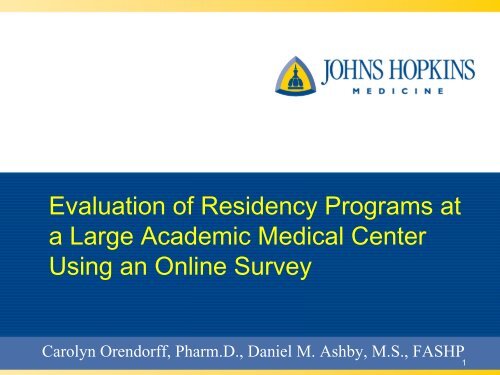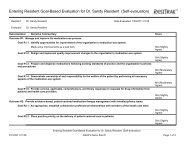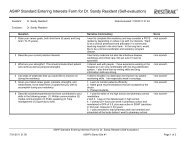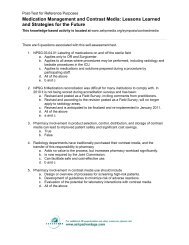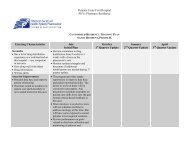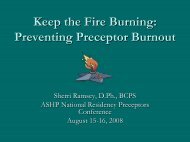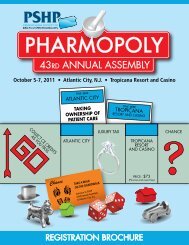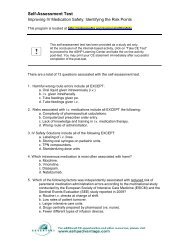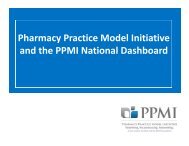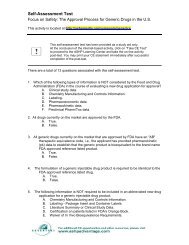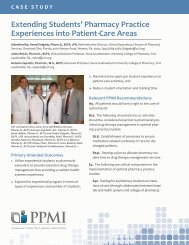Evaluation of Residency Programs at a Large ... - Ashpmedia.org
Evaluation of Residency Programs at a Large ... - Ashpmedia.org
Evaluation of Residency Programs at a Large ... - Ashpmedia.org
- No tags were found...
You also want an ePaper? Increase the reach of your titles
YUMPU automatically turns print PDFs into web optimized ePapers that Google loves.
KJMC/LIU <strong>Residency</strong> Program 5 Pharmacy (PGY-1) 1 Critical Care (PGY-2) 1 Internal Medicine (PGY-2) 1 Geri<strong>at</strong>rics (PGY-2) Director Associ<strong>at</strong>e Director Coordin<strong>at</strong>or 7 Faculty Preceptors18 total Residentsand Preceptors
Background• Commission on Accredit<strong>at</strong>ion <strong>of</strong> HealthcareManagement Educ<strong>at</strong>ion (CAHME)• Mission and Metrics• Evalu<strong>at</strong>e extent to which students <strong>at</strong>tain competencies• Accredit<strong>at</strong>ion Council for Pharmacy Educ<strong>at</strong>ion• <strong>Evalu<strong>at</strong>ion</strong> plan to assess achievement <strong>of</strong> mission and goals• Pr<strong>of</strong>essional competencies and outcome expect<strong>at</strong>ions• Assessment <strong>of</strong> student learning / curriculum effectiveness• University <strong>of</strong> Kentucky• AJHP 2005; 62:2283-8; Kelly Smith and Frank Romanelli3
Methods• Online survey• 43 questions (~ 20 minutes)• Likert scale (included “n/a” and “unsure”)• Option to skip questions• Invit<strong>at</strong>ion sent with link to survey• “Would you be so kind ….”• Strengthen program …• Anonymous• Survey deadline <strong>of</strong> 4 weeks• Reminder communic<strong>at</strong>ion after 2 weeks6
Results - Demographics• Response r<strong>at</strong>e: 29/47 (61.7%)• Average age: 29 years (range: 26-36)• Gender: 69% female• <strong>Residency</strong> <strong>at</strong> JHH (100%)• Pharmacy Practice: 21/28 (75%)• Specialty:15/22 (68%)• St<strong>at</strong>e <strong>of</strong> residence• MD: 5 (18%)• PA: 3 (11%)• FL, MA, NC, OH, TX: 2 (7.1% each)• GA, HI, IL, MI, MS, NJ, OR, TN, VA, WA: 1 (3.6% each)7
DemographicsDegree• Pharm.D.: 29/29 (100%)• Bachelor <strong>of</strong> Science: 7/29 (24%)• MPH or MBA: 3/29 (10%)Certific<strong>at</strong>ion• Board Certified Pharmacy Specialist: 12/26 (46%)• Board Certified Oncology Pharmacist: 6/26 (23%)8
Employment St<strong>at</strong>usEmployment: 28/29 (97%) full-time, 1/29 (3%) part-timeTerm with employer• < 2 years 21/29 (72%)• 2-4 years 1/29 (28%)Current position• Clinical pharmacy specialist 21/25 (75%)• Faculty 5/28 (18%)• Pharmacy resident (specialty) 3/28 (11%)• Supervisory position (other) 2/28 (7%)9
Employment St<strong>at</strong>usCurrent practice setting• Hospital and/or Health-system 24/29 (83%)• Academia 6/29 (21%)• Ambul<strong>at</strong>ory Care 4/29 (14%)Size <strong>of</strong> institution• > 601 beds 13/29 (45%)• 301-600 beds 10/29 (35%)• 1-300 beds 4/29 (14%)10
Employment St<strong>at</strong>us• P<strong>at</strong>ient care 26/28 (93%)• Drug inform<strong>at</strong>ion 23/28 (82%)• Student precepting, medic<strong>at</strong>ion use evalu<strong>at</strong>ion,adverse drug reaction monitoring 21/28 (75%)• P<strong>at</strong>ient counseling 20/28 (71%)• Educ<strong>at</strong>ion/staff development 18/28 (64%)• Resident precepting 17/28 (61%)• Drug policy/formulary management 16/28 (57%)• Research, medic<strong>at</strong>ion safety 14/28 (50%)11
<strong>Residency</strong> Activities• 80-100% were “very” or “somewh<strong>at</strong> s<strong>at</strong>isfied with”:• Rot<strong>at</strong>ions <strong>of</strong>fered, on-call, teaching experience,post-residency prepar<strong>at</strong>ion, pr<strong>of</strong>essionaldevelopment, work environment, staffingarea/requirements, research project,pharmacotherapy rounds• 10-20% were “somewh<strong>at</strong> or very diss<strong>at</strong>isfied” with:• DUE project• Management seminar12
Preceptor Perception• 80% r<strong>at</strong>ed all components <strong>of</strong> s<strong>at</strong>isfaction withpreceptors as “very” or “somewh<strong>at</strong> s<strong>at</strong>isfied”• Examples: Perception <strong>of</strong> resident’s needs,leadership, commitment, teaching abilities,adaptability, deleg<strong>at</strong>ion, mentorship, feedback• 10% r<strong>at</strong>ed “somewh<strong>at</strong> or very diss<strong>at</strong>isfied”• Sponsor/facilit<strong>at</strong>or role as mentor• Deleg<strong>at</strong>es appropri<strong>at</strong>ely13
<strong>Residency</strong> Perception• Over 90% <strong>of</strong> responders agreed the program supported thedevelopment <strong>of</strong> knowledge, skills, and abilities in the following:• Acute care, multi-disciplinary collabor<strong>at</strong>ion, controlledsubstances handling, safety, drug inform<strong>at</strong>ion, drug policydevelopment, leadership, medic<strong>at</strong>ion use system,communic<strong>at</strong>ion, practice management, primary care,research, teaching• Over 20% responders thought the residency could improve in:• Reimbursement, medical writing, budget/ fiscalmanagement, teaching skills, developing innov<strong>at</strong>iveservices, drug policy development, drug inform<strong>at</strong>ion andinform<strong>at</strong>ion systems14
Global <strong>Residency</strong> PerceptionOver 90% <strong>of</strong> responders th<strong>at</strong> thought:• The residency met or surpassed expect<strong>at</strong>ions• They were exposed to a variety <strong>of</strong> clinicalproblems/situ<strong>at</strong>ions• The program helps produce pharmacy leaders• They would recommend this residency to others• They were s<strong>at</strong>isfied with the program• They were s<strong>at</strong>isfied with the leadership from theresidency program director15
Lessons Learned• Importance <strong>of</strong> staying in touch• Avoid questions th<strong>at</strong> hinder the responder’sanonymonity• Keep questions simple to answer andevalu<strong>at</strong>e• Focus on areas <strong>of</strong> interest and possibleaction• Keep key players involved• Value to a trial run on similar audience16
Conclusion• The online survey was an effective method <strong>of</strong>obtaining feedback from past residents• Objectives <strong>of</strong> the programs are being achieved• Survey identified opportunities for improvement• Improvement opportunities may be <strong>of</strong> value toother programs• Action plans should be developed andimplemented by the <strong>Residency</strong> PreceptorCommittee17


